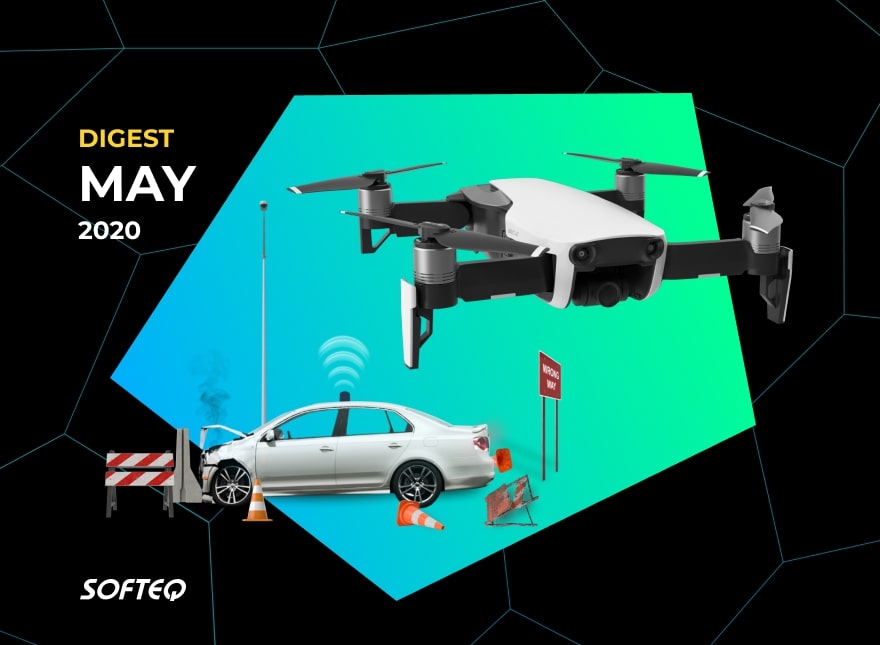This is What Techies Talked about in May

In this issue of the Tech Digest: drones reduce industrial inspection costs by 50%, Artificial Intelligence might be heading in the wrong direction, and COVID-19 contact tracing apps infringe on data privacy. All that and more in a 10-minute read.
In 2020, the number of new IoT devices will drop 18%. Which IoT sectors are growing despite the crisis?
The pandemic is likely to cause an 18% decline in new IoT deployments this year. That’s what the ABI Research study says, citing fleet management, digital signage, and heavy equipment among the biggest losers. At the same time, IoT-enabled technologies that allow companies to operate and monitor assets remotely are set for substantial long-term investments. These include inventory management and condition-based monitoring systems. Medical tech is another big winner. According to Network World, 79% of healthcare providers with revenue over $100 million have new IoT devices in production. Gartner, meanwhile, predicts a 13% increase in medical IoT spending in the next fiscal year. On the whole, the Internet of Things market is expected to bounce back quickly, but the challenges that force companies to abandon 30% of IoT projects at the Proof of Concept stage remain in place.
Robots are getting smarter. Are we ready to open up a Pandora’s box of Artificial Intelligence and peek inside?
What makes humans different from droids is perhaps the ability to anticipate other people’s thoughts and intentions. Take driving, for example. Every time you’re cruising down the Sunset Strip, you know the guy in a yellow convertible probably won’t give you any space to maneuver. But how do you know what’s going on inside the computerized mind in the autonomous Uber cab driving next to you? Tom Simonite, a senior writer at WIRED, is discussing a change he has noticed in connected vehicles’ behavior. Autonomous cars used to cautiously wait for stray bikes to meander back to the bike lane as if they knew that somebody's absent-minded friend or family member was riding them. Now they just rip past sluggish humans! Efficient? Yes. But where's the soul? Technology companies have long been on a quest to create fully automated robots: self-driving cars, intelligent delivery drones, and smart factory equipment. Ben Shneiderman, a computer scientist from the University of Maryland, warns technopreneurs against the robotic future. According to Mr. Shneiderman, machines should be working alongside humans rather than replace them. For every robot, we need an equivalent of a flight data recorder so that human technicians can detect malfunctions and intervene before a disaster strikes. As robots are gradually filling dangerous and low-paid jobs amid the coronavirus crisis, it’s time we gave this warning a thorough consideration. A recent article by The New York Times describes a perfect use case for meaningful human-machine cooperation.
Inspection drones are taking off. What is the technology missing to go mainstream?
In 2020, businesses and governments alike are beginning to investigate technologies for autonomous delivery, remote equipment maintenance, and public safety. Here’s where unmanned aerial vehicles (UAVs), or simply drones, come in useful. In our latest blog post, the Softeq team takes a closer look at drone-based industrial inspection solutions, which account for 28% of all commercial UAV use cases. Although drones help oil and gas, construction, and utility companies reduce inspection costs by up to 50%, there are multiple hurdles to implementing the technology on a broader scale. First and foremost, UAVs lack the cognitive ability to avoid obstacles without human guidance. Second, heavy computing operations performed on the device cause a battery drain. Finally, the controversial regulations that prevent UAVs from working in tandem with delivery vans and flying in densely populated areas remain in effect. That being said, there have been notable advances in drone technology in the past few months. The Ishikawa Group Laboratory from the University of Tokyo has created a robotic arm that hands parcels over to delivery drones using computer vision. Zipline drones are delivering medical equipment and protective gear to Novant Health medical center in North Carolina. And there’s an article from ArsTechnica that gives us hope for more powerful and cheaper batteries, which could help drones stay in flight longer.
Society embraces telehealth. Does the new technology put user data at risk?
The pandemic has given a long-awaited boost to the telemedicine industry. In the USA alone, coronavirus-related virtual doctor visits could top 900 million by the end of this year. Besides televised consultations, both healthcare providers and technology startups are rushing to build mobile applications and chatbots that help evaluate users’ virus exposure and spot coronavirus symptoms early on. While such apps could be a useful supplement to manual testing, it is not always clear what data they collect and how this data will be used in the future. To help users navigate the changing COVID-19 tracker landscape, MIT Technology Review developed a database that documents contact tracing applications from 29 countries. Ensuring HIPAA compliance is another way to promote transparency in telemedicine. While the rules only apply to the US healthcare system, they might serve as a cheat sheet for global medical care providers and technology companies looking to keep ahead of the international regulatory curve. Adam Uzialko, a freelance editor at Business.com, has prepared a detailed guide for healthcare organizations looking to implement a telehealth solution.
What opportunities and challenges does Artificial Intelligence bring to medical image analysis?
AI-based medical imaging is another technology gaining momentum in the coronavirus-hit world. By applying Machine Learning algorithms to CT, MRI, and X-ray scans, physicians can detect abnormalities that might otherwise remain hidden in vast amounts of hospital data. The first studies suggesting AI is better at diagnosing some forms of cancer than human doctors emerged in early 2013. Today, smart algorithms reduce the number of incorrectly identified breast cancers to 5.7% in America and 1.2% in the UK. A new article by The Healthcare Guys weighs in on the benefits and challenges of AI-assisted medical imaging.
